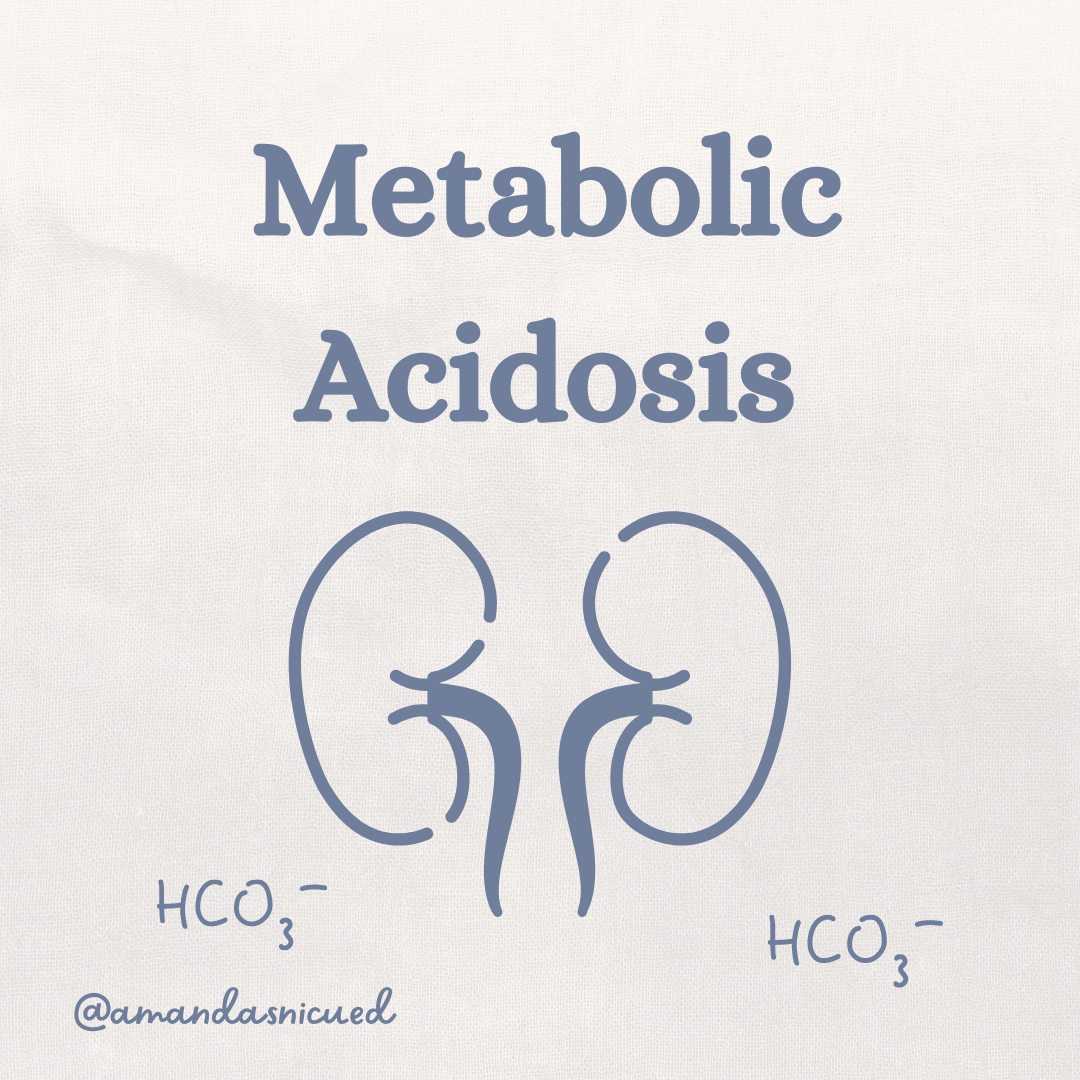Amanda's NICU ED Blogs
RECENT BLOG ARTICLES

Interventions for Metabolic Acidosis
Blood Gas Interpretation & Interventions
Last week we reviewed the interventions we can anticipate when a baby has respiratory acidosis. This week let's review metabolic acidosis...

Need a Refresher on Blood Gas Interpretation? Click Here
Metabolic acidosis is a common problem we see in critically ill newborns due to an accumulation of acid (which lowers the pH) or a loss of base. Some situations that cause a build up acid include:
tissue hypoxia
hypothermia
hypovolemia
sepsis
NEC
bicarbonate loss from immature kidneys
and other severe illnesses
Metabolic acidosis can be divided into two categories: an elevated anion gap or a normal anion gap.
What's the anion gap??
The anion gap measures the difference between negatively charged (anions) and positively charged (cations) electrolytes in the blood. This helps identify the potential cause of metabolic acidosis. The anion gap is calculated by adding the chloride (Cl-) and bicarbonate (HCO3-) and subtracting that number from the sum of sodium (Na+) and potassium (K+).
Anion Gap = [(Na+) + (K+)] - [(Cl-) + (HCO3-)]
A normal anion gap in newborns is 8-16 mEq/L.
An anion gap >16mEq/L is highly predictive of lactic acidosis.
Metabolic acidosis with a normal anion gap most commonly occurs due to renal tubular acidosis and renal HCO3 loss.
I found this great video from Osmosis that explains the Anion Gap so well! Click the button below to check it out 🤓
What interventions can we anticipate if our patient has metabolic acidosis??
The most important intervention when there is metabolic acidosis is correction of the underlying cause (e.g. if concerned for sepsis treating with antibiotics; if there is hypoxemia improving oxygenation and ventilation; if hypovolemic giving volume).
Adding acetate to IV fluids in premature newborns with renal tubular acidosis is a common method to buffer the loss of base.
If there are signs of hypovolemia, a bolus (10mL/kg of NS) can be given. When a patient is not hypovolemic, volume replacement is poorly tolerated due to decreased myocardial contractility.
Sodium Bicarbonate (NaHCO3) is another method of providing base when severe metabolic acidosis is present, however there is controversy surrounding NaHCO3 and it has been quoted as "basically a useless therapy". If used, NaHCO3 must be used with caution as it increases the risk of intraventricular hemorrhage in preterm neonates. Additionally, those receiving NaHCO3 must be well ventilated as there is an increase in CO2 production after administration.

What topic do you want to review next? Email me and let me know what you have questions about! I love hearing from you 😊
Thank you for all the work you do,
Amanda xoxo
Missed my other newsletters? Click here to read them!
Let's Study Together! Join my Certification Course
References:
Curtis, S. (2025). Fluid, Electrolytes, and Acid-Base Homeostasis in Fanaroff and Martin's Neonatal Perinatal Medicine (12th Ed.) Elsevier
Wright, C., Posencheg, M. A., & Seri, I. (2024). Fluid, Electrolyte, and Acid-Base Balance in Avery's Diseases of the Newborn (11th Ed.) Elsevier
Aschner, J. L., & Poland, R. L. (2008). Sodium bicarbonate: basically useless therapy. Pediatrics, 122(4), 831–835. https://doi.org/10.1542/peds.2007-2400
Respiratory and Blood Gas Blogs

Interventions for Metabolic Acidosis
Blood Gas Interpretation & Interventions
Last week we reviewed the interventions we can anticipate when a baby has respiratory acidosis. This week let's review metabolic acidosis...

Need a Refresher on Blood Gas Interpretation? Click Here
Metabolic acidosis is a common problem we see in critically ill newborns due to an accumulation of acid (which lowers the pH) or a loss of base. Some situations that cause a build up acid include:
tissue hypoxia
hypothermia
hypovolemia
sepsis
NEC
bicarbonate loss from immature kidneys
and other severe illnesses
Metabolic acidosis can be divided into two categories: an elevated anion gap or a normal anion gap.
What's the anion gap??
The anion gap measures the difference between negatively charged (anions) and positively charged (cations) electrolytes in the blood. This helps identify the potential cause of metabolic acidosis. The anion gap is calculated by adding the chloride (Cl-) and bicarbonate (HCO3-) and subtracting that number from the sum of sodium (Na+) and potassium (K+).
Anion Gap = [(Na+) + (K+)] - [(Cl-) + (HCO3-)]
A normal anion gap in newborns is 8-16 mEq/L.
An anion gap >16mEq/L is highly predictive of lactic acidosis.
Metabolic acidosis with a normal anion gap most commonly occurs due to renal tubular acidosis and renal HCO3 loss.
I found this great video from Osmosis that explains the Anion Gap so well! Click the button below to check it out 🤓
What interventions can we anticipate if our patient has metabolic acidosis??
The most important intervention when there is metabolic acidosis is correction of the underlying cause (e.g. if concerned for sepsis treating with antibiotics; if there is hypoxemia improving oxygenation and ventilation; if hypovolemic giving volume).
Adding acetate to IV fluids in premature newborns with renal tubular acidosis is a common method to buffer the loss of base.
If there are signs of hypovolemia, a bolus (10mL/kg of NS) can be given. When a patient is not hypovolemic, volume replacement is poorly tolerated due to decreased myocardial contractility.
Sodium Bicarbonate (NaHCO3) is another method of providing base when severe metabolic acidosis is present, however there is controversy surrounding NaHCO3 and it has been quoted as "basically a useless therapy". If used, NaHCO3 must be used with caution as it increases the risk of intraventricular hemorrhage in preterm neonates. Additionally, those receiving NaHCO3 must be well ventilated as there is an increase in CO2 production after administration.

What topic do you want to review next? Email me and let me know what you have questions about! I love hearing from you 😊
Thank you for all the work you do,
Amanda xoxo
Missed my other newsletters? Click here to read them!
Let's Study Together! Join my Certification Course
References:
Curtis, S. (2025). Fluid, Electrolytes, and Acid-Base Homeostasis in Fanaroff and Martin's Neonatal Perinatal Medicine (12th Ed.) Elsevier
Wright, C., Posencheg, M. A., & Seri, I. (2024). Fluid, Electrolyte, and Acid-Base Balance in Avery's Diseases of the Newborn (11th Ed.) Elsevier
Aschner, J. L., & Poland, R. L. (2008). Sodium bicarbonate: basically useless therapy. Pediatrics, 122(4), 831–835. https://doi.org/10.1542/peds.2007-2400
Cardiac Blogs

Interventions for Metabolic Acidosis
Blood Gas Interpretation & Interventions
Last week we reviewed the interventions we can anticipate when a baby has respiratory acidosis. This week let's review metabolic acidosis...

Need a Refresher on Blood Gas Interpretation? Click Here
Metabolic acidosis is a common problem we see in critically ill newborns due to an accumulation of acid (which lowers the pH) or a loss of base. Some situations that cause a build up acid include:
tissue hypoxia
hypothermia
hypovolemia
sepsis
NEC
bicarbonate loss from immature kidneys
and other severe illnesses
Metabolic acidosis can be divided into two categories: an elevated anion gap or a normal anion gap.
What's the anion gap??
The anion gap measures the difference between negatively charged (anions) and positively charged (cations) electrolytes in the blood. This helps identify the potential cause of metabolic acidosis. The anion gap is calculated by adding the chloride (Cl-) and bicarbonate (HCO3-) and subtracting that number from the sum of sodium (Na+) and potassium (K+).
Anion Gap = [(Na+) + (K+)] - [(Cl-) + (HCO3-)]
A normal anion gap in newborns is 8-16 mEq/L.
An anion gap >16mEq/L is highly predictive of lactic acidosis.
Metabolic acidosis with a normal anion gap most commonly occurs due to renal tubular acidosis and renal HCO3 loss.
I found this great video from Osmosis that explains the Anion Gap so well! Click the button below to check it out 🤓
What interventions can we anticipate if our patient has metabolic acidosis??
The most important intervention when there is metabolic acidosis is correction of the underlying cause (e.g. if concerned for sepsis treating with antibiotics; if there is hypoxemia improving oxygenation and ventilation; if hypovolemic giving volume).
Adding acetate to IV fluids in premature newborns with renal tubular acidosis is a common method to buffer the loss of base.
If there are signs of hypovolemia, a bolus (10mL/kg of NS) can be given. When a patient is not hypovolemic, volume replacement is poorly tolerated due to decreased myocardial contractility.
Sodium Bicarbonate (NaHCO3) is another method of providing base when severe metabolic acidosis is present, however there is controversy surrounding NaHCO3 and it has been quoted as "basically a useless therapy". If used, NaHCO3 must be used with caution as it increases the risk of intraventricular hemorrhage in preterm neonates. Additionally, those receiving NaHCO3 must be well ventilated as there is an increase in CO2 production after administration.

What topic do you want to review next? Email me and let me know what you have questions about! I love hearing from you 😊
Thank you for all the work you do,
Amanda xoxo
Missed my other newsletters? Click here to read them!
Let's Study Together! Join my Certification Course
References:
Curtis, S. (2025). Fluid, Electrolytes, and Acid-Base Homeostasis in Fanaroff and Martin's Neonatal Perinatal Medicine (12th Ed.) Elsevier
Wright, C., Posencheg, M. A., & Seri, I. (2024). Fluid, Electrolyte, and Acid-Base Balance in Avery's Diseases of the Newborn (11th Ed.) Elsevier
Aschner, J. L., & Poland, R. L. (2008). Sodium bicarbonate: basically useless therapy. Pediatrics, 122(4), 831–835. https://doi.org/10.1542/peds.2007-2400
hey nurses don't miss out
© Copyright 2024. AmandasNICUEd. All rights reserved. | Terms & Conditions | Privacy Policy Contact: [email protected]


